
4-Day Copenhagen Itinerary including a Day Trip to Roskilde's Viking Museum
 4 Day Tour of Copenhagen
4 Day Tour of Copenhagen
Overview
Trip Map
Itinerary
Inclusions
Reviews







4 Days 3 Nights
Best Time: Jan-Dec
Day Cruises
Exploring Scenic Countryside
Enjoy four days in Copenhagen, a city where royal history and modern design blend seamlessly. From the charming streets of Nyhavn to the enchanting Tivoli Gardens, you’ll find something charming in every corner of the Danish capital. Enjoy a unique day trip to Roskilde, where the echoes of Viking conquests still resonate at the Viking Museum. Sail through hidden gems on an exclusive boat cruise, revealing Copenhagen's vibrant cultural tapestry. With a private walking tour led by a knowledgeable guide and the detailed travel guidance accessible through our Go Real Travel mobile app, your journey will be as enlightening as it is delightful.
- Relive history on a private tour past the colorful facades of Nyhavn & regal Christiansborg Palace.
- Enjoy thrills at Tivoli Gardens, a historic amusement park with lush landscapes and entertainment.
- Discover history at the Viking Museum on an excursion to the scenic seaside town of Roskilde.
- Experience Copenhagen's contemporary heartbeat on a boat cruise in its bustling harbors and canals.
- Savor the essence of Danish design, lifestyle, and cuisine in Copenhagen’s trendy districts.
Enjoy four days in Copenhagen, a city where royal history and modern design blend seamlessly. From the charming streets of Nyhavn to the enchanting Tivoli Gardens, you’ll find something charming in every corner of the Danish capital. Enjoy a unique day trip to Roskilde, where the echoes of Viking conquests still resonate at the Viking Museum. Sail through hidden gems on an exclusive boat cruise, revealing Copenhagen's vibrant cultural tapestry. With a private walking tour led by a knowledgeable guide and the detailed travel guidance accessible through our Go Real Travel mobile app, your journey will be as enlightening as it is delightful.
- Relive history on a private tour past the colorful facades of Nyhavn & regal Christiansborg Palace.
- Enjoy thrills at Tivoli Gardens, a historic amusement park with lush landscapes and entertainment.
- Discover history at the Viking Museum on an excursion to the scenic seaside town of Roskilde.
- Experience Copenhagen's contemporary heartbeat on a boat cruise in its bustling harbors and canals.
- Savor the essence of Danish design, lifestyle, and cuisine in Copenhagen’s trendy districts.

Christiansborg Palace
National Site

The Little Mermaid
Literature

Nyhavn
Historic Landmarks

Tivoli Gardens
Amusement & Water Parks

Amalienborg Palace
Historic Landmarks

Frederiksberg
Nightlife & Local Scene

The National Museum
Museums & Galleries
Must see sights

Christiansborg Palace
National Site

The Little Mermaid
Literature

Nyhavn
Historic Landmarks

Tivoli Gardens
Amusement & Water Parks

Amalienborg Palace
Historic Landmarks

Frederiksberg
Nightlife & Local Scene

The National Museum
Museums & Galleries
Starting from
$699
per person
 Not included
Not included Secure Your Customizable Trip
Enter your details to embark on a journey that can be tailored just for you.
Start
Travelers
0 travelers
Add Room
Remove Room
Preferred Hotel Stars
Select Hotel Stars
Craft Your Own Itinerary
Select your interests and destinations for a trip plan inspired by you.
Copenhagen City Break Trip - Map & Itinerary
Enable/Disable Map Scrolling
Click To Make Map Interactive

Copenhagen City Break Trip Timeline
 Edit Details
Edit DetailsArrival
3 nights
Copenhagen
Denmark
Departure
Day-By-Day Itinerary of Copenhagen City Break Trip

Day 1
Arrive Copenhagen
Day 1
Arrive Copenhagen



To Be Determined
Airport Pickup by Taxi
For your arrival in Copenhagen, we will provide information on the customs and passport procedures, how to pick up your Copenhagen Card, advice on taking a taxi to your hotel, including an estimate of the cost and time of the ride to your hotel, basic alternative directions for taking a train or metro into central Copenhagen to save on the taxi fare, as well as advice on how to bike around Copenhagen.

Day 1
Arrive Copenhagen


Day 1
Arrive Copenhagen




To Be Determined:
Airport Pickup by Taxi
Mid-Day/Afternoon:
Nyhavn & Royal Quarter
Late Afternoon/Early Evening:
City Center

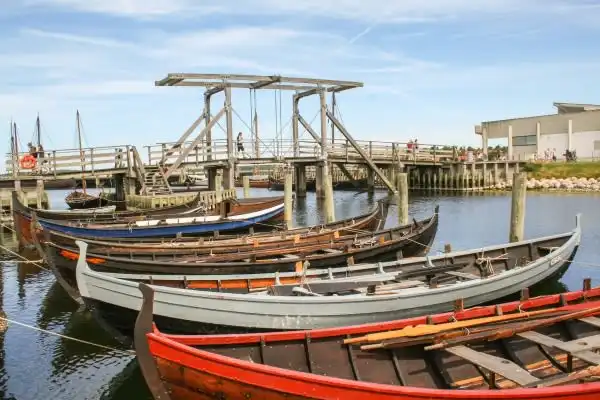
Day 2
Copenhagen
Day 2
Copenhagen



Morning to Afternoon
Roskilde
A mere 25-minute train journey west of Copenhagen in the region of West Zealand, Roskilde is an ancient Viking city with a number of important historical sites as well as modern attractions. Established over a millennium ago, Roskilde was once one of the most important settlements in Denmark due to its ecclesiastical significance, and while it is quieter and lower-key now, both its Viking and Christian heritage remain on proud display; meanwhile, the annual Roskilde Festiva,l inspired by Woodstock, gives it a chance to show its loud side. But for many, the highlight of the visit to Roskilde will be the Viking Ship Museum, where history comes to life through the remarkable preservation and reconstruction of authentic Viking ships, offering an immersive glimpse into the seafaring prowess and cultural richness of the Viking Age.

Roskilde - Viking Ship Museum
Discover the Highly-Advanced Culture of the Vikings
Show More

Roskilde - Ragnarock Museum
It's Showtime at the RAGNAROCK Museum
Show More

Roskilde - Roskilde Cathedral
Wonder at This 900-year-old Architectural Innovation
Show More

Roskilde - Roskilde Museum
Dig into the History of This UNESCO- Heritage City
Show More

Roskilde - Viking Ship Museum
Discover the Highly-Advanced Culture of the Vikings
Show More

Roskilde - Ragnarock Museum
It's Showtime at the RAGNAROCK Museum
Show More

Roskilde - Roskilde Cathedral
Wonder at This 900-year-old Architectural Innovation
Show More

Roskilde - Roskilde Museum
Dig into the History of This UNESCO- Heritage City
Show More
prev
next

Day 2
Copenhagen


Roskilde - Viking Ship Museum
 Highlight of Roskilde
Highlight of RoskildeDiscover the Highly-Advanced Culture of the Vikings
The Viking Ship Museum in Roskilde, Denmark, showcases Viking maritime history with five original ships excavated from the Roskilde Fjord. It offers insights into Viking shipbuilding, navigation, and daily life through exhibits and hands-on activities, including sailing on replica ships. This museum highlights the Vikings' seafaring achievements and their impact on European history, making it a vital visit for anyone interested in Norse culture.
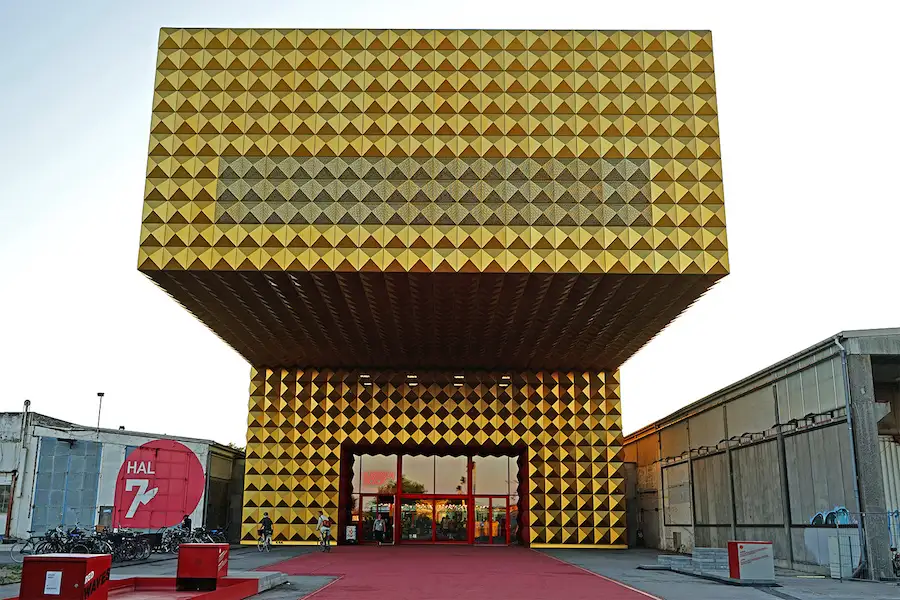
Roskilde - Ragnarock Museum
 Highlight of Roskilde
Highlight of RoskildeIt's Showtime at the RAGNAROCK Museum
You might be cool, but are you Danish cool? Ragnarock is dedicated to exhibiting Denmark’s participation in, and contribution to, pop, rock, and youth culture. The museum sits in a big, gold box. What else do you need to know?

Roskilde - Roskilde Cathedral
 Highlight of Roskilde
Highlight of RoskildeWonder at This 900-year-old Architectural Innovation
Roskilde Cathedral, a UNESCO World Heritage site in Denmark, is a pioneering Gothic structure built from brick in the 12th and 13th centuries, and strongly influenced Northern Europe's ecclesial architecture. Serving as the final resting place for Danish monarchs, it showcases a rich array of royal tombs across various styles. The blend of Gothic and Romanesque design, with notable expansions over time, highlights Denmark's historical and architectural legacy.

Roskilde - Roskilde Museum
 Highlight of Roskilde
Highlight of RoskildeDig into the History of This UNESCO- Heritage City
An amiable visit to the Rosklide Museum will deepen your understanding of this UNESCO-Heritage site. With a historical narrative spanning from the Stone Ages through the Vikings to present, the museum will connect you to Danish history, but also Danish sensibilities and sensitivities. When you've perused the exhibits, take a break for a coffee and light fare at the museum's Cafe Klai.

Roskilde - Viking Ship Museum
 Highlight of Roskilde
Highlight of RoskildeDiscover the Highly-Advanced Culture of the Vikings
The Viking Ship Museum in Roskilde, Denmark, showcases Viking maritime history with five original ships excavated from the Roskilde Fjord. It offers insights into Viking shipbuilding, navigation, and daily life through exhibits and hands-on activities, including sailing on replica ships. This museum highlights the Vikings' seafaring achievements and their impact on European history, making it a vital visit for anyone interested in Norse culture.

Roskilde - Ragnarock Museum
 Highlight of Roskilde
Highlight of RoskildeIt's Showtime at the RAGNAROCK Museum
You might be cool, but are you Danish cool? Ragnarock is dedicated to exhibiting Denmark’s participation in, and contribution to, pop, rock, and youth culture. The museum sits in a big, gold box. What else do you need to know?

Roskilde - Roskilde Cathedral
 Highlight of Roskilde
Highlight of RoskildeWonder at This 900-year-old Architectural Innovation
Roskilde Cathedral, a UNESCO World Heritage site in Denmark, is a pioneering Gothic structure built from brick in the 12th and 13th centuries, and strongly influenced Northern Europe's ecclesial architecture. Serving as the final resting place for Danish monarchs, it showcases a rich array of royal tombs across various styles. The blend of Gothic and Romanesque design, with notable expansions over time, highlights Denmark's historical and architectural legacy.

Roskilde - Roskilde Museum
 Highlight of Roskilde
Highlight of RoskildeDig into the History of This UNESCO- Heritage City
An amiable visit to the Rosklide Museum will deepen your understanding of this UNESCO-Heritage site. With a historical narrative spanning from the Stone Ages through the Vikings to present, the museum will connect you to Danish history, but also Danish sensibilities and sensitivities. When you've perused the exhibits, take a break for a coffee and light fare at the museum's Cafe Klai.
prev
next

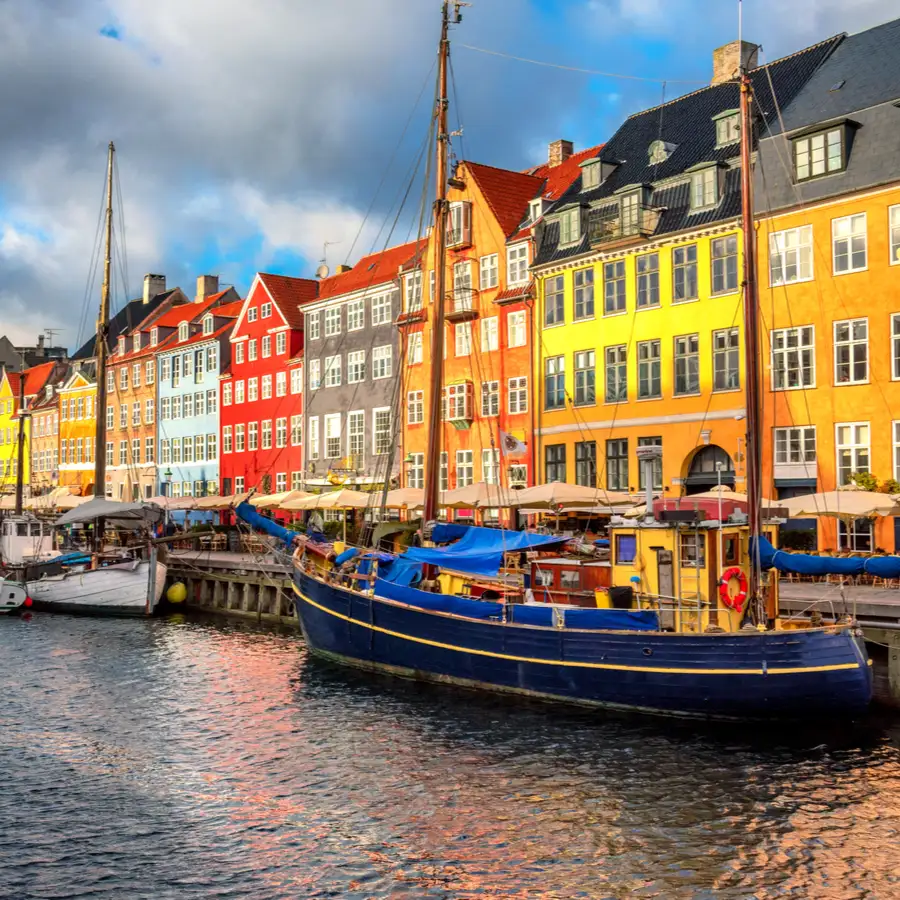
Day 3
Copenhagen
Day 3
Copenhagen



9:00 AM - 12:00 PM
Copenhagen Walking Tour
Breeze through major sites of Copenhagen with this 3-hour tour that includes the Christiansborg Palace, Nyhavn, and, of course, the Little Mermaid. Durning the walk, your guide will entertain and inform you with the surprising history of this great city, all while doling out pointers for the best restaurants and place to explore for the rest of your stay.

Christiansborg Palace
Christiansborg Contains Some Unique Facts About the Danish Government
Show More

Nyhavn
Find a friendly port in Nyhavn
Show More

Christiansborg Palace
Christiansborg Contains Some Unique Facts About the Danish Government
Show More

Nyhavn
Find a friendly port in Nyhavn
Show More

Christiansborg Palace
Christiansborg Contains Some Unique Facts About the Danish Government
Show More

Nyhavn
Find a friendly port in Nyhavn
Show More
prev
next

Day 3
Copenhagen


Christiansborg Palace
 Highlight of Copenhagen Walking Tour
Highlight of Copenhagen Walking Tour Christiansborg Contains Some Unique Facts About the Danish Government
Christiansborg Palace, located on Slotsholmen in Copenhagen, serves as the seat of Denmark's government and uniquely, under its one roof, all three branches of government: the Parliament, Supreme Court, and Ministry of State. With a history dating back to the 12th century, the palace has been rebuilt several times. Visitors can explore the Royal Reception Rooms, the Great Hall with historic tapestries, and ancient ruins beneath the palace, providing a glimpse into Denmark's political and royal heritage through its stunning architecture and interiors.

Nyhavn
 Highlight of Copenhagen Walking Tour
Highlight of Copenhagen Walking Tour Find a friendly port in Nyhavn
Copenhagen'sNyhavn, or "New Harbor," is a lively district known for its historic canal, colorful townhouses, and congenial atmosphere. Once a commercial port, it's now a popular spot for dining and canal tours, blending maritime history with modern culture. Its unique charm and historical significance make this an imperative to visit.

Christiansborg Palace
 Highlight of Copenhagen Walking Tour
Highlight of Copenhagen Walking Tour Christiansborg Contains Some Unique Facts About the Danish Government
Christiansborg Palace, located on Slotsholmen in Copenhagen, serves as the seat of Denmark's government and uniquely, under its one roof, all three branches of government: the Parliament, Supreme Court, and Ministry of State. With a history dating back to the 12th century, the palace has been rebuilt several times. Visitors can explore the Royal Reception Rooms, the Great Hall with historic tapestries, and ancient ruins beneath the palace, providing a glimpse into Denmark's political and royal heritage through its stunning architecture and interiors.

Nyhavn
 Highlight of Copenhagen Walking Tour
Highlight of Copenhagen Walking Tour Find a friendly port in Nyhavn
Copenhagen'sNyhavn, or "New Harbor," is a lively district known for its historic canal, colorful townhouses, and congenial atmosphere. Once a commercial port, it's now a popular spot for dining and canal tours, blending maritime history with modern culture. Its unique charm and historical significance make this an imperative to visit.

Christiansborg Palace
 Highlight of Copenhagen Walking Tour
Highlight of Copenhagen Walking Tour Christiansborg Contains Some Unique Facts About the Danish Government
Christiansborg Palace, located on Slotsholmen in Copenhagen, serves as the seat of Denmark's government and uniquely, under its one roof, all three branches of government: the Parliament, Supreme Court, and Ministry of State. With a history dating back to the 12th century, the palace has been rebuilt several times. Visitors can explore the Royal Reception Rooms, the Great Hall with historic tapestries, and ancient ruins beneath the palace, providing a glimpse into Denmark's political and royal heritage through its stunning architecture and interiors.

Nyhavn
 Highlight of Copenhagen Walking Tour
Highlight of Copenhagen Walking Tour Find a friendly port in Nyhavn
Copenhagen'sNyhavn, or "New Harbor," is a lively district known for its historic canal, colorful townhouses, and congenial atmosphere. Once a commercial port, it's now a popular spot for dining and canal tours, blending maritime history with modern culture. Its unique charm and historical significance make this an imperative to visit.
prev
next


Day 4
Depart Copenhagen
Day 4
Depart Copenhagen


Morning to Afternoon
Christianshavn
Once containing military barracks, the man-made islands that make up Christianhavn in Copenhagen are now known for canals, colorful houses, and bohemian atmosphere. This area features narrow streets lined with cafes and boutiques, the autonomous district of Freetown Christiania, and the Church of Our Saviour with its panoramic views. This area combines a maritime heritage with a vibrant, sometimes discombobulating, cultural scene.

Freetown Christiania
Anarchist community as tourist attraction? Read on...
Show More

Royal Danish Opera House
A modern symphony for the ears... and the eyes.
Show More

Freetown Christiania
Anarchist community as tourist attraction? Read on...
Show More

Royal Danish Opera House
A modern symphony for the ears... and the eyes.
Show More

Freetown Christiania
Anarchist community as tourist attraction? Read on...
Show More

Royal Danish Opera House
A modern symphony for the ears... and the eyes.
Show More
prev
next

Day 4
Depart Copenhagen

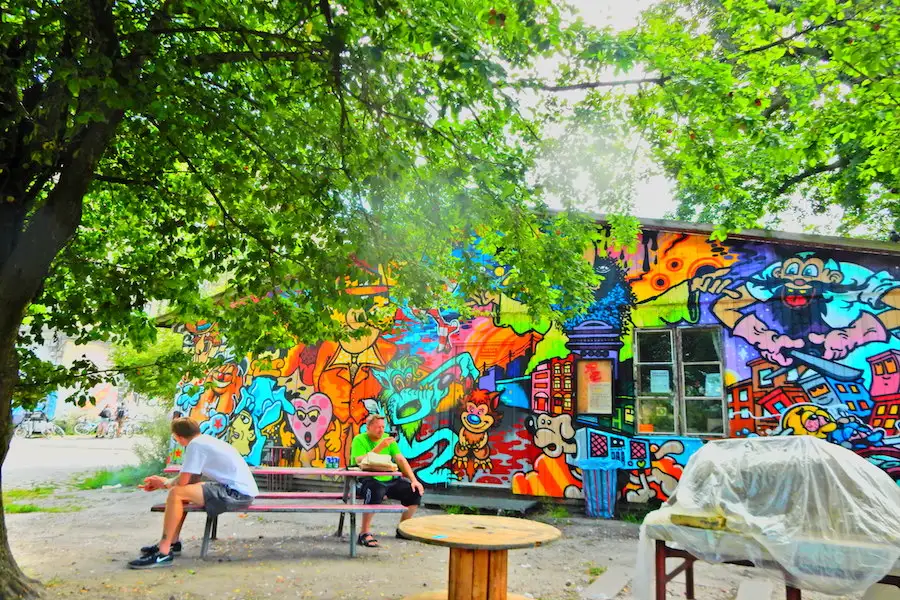
Freetown Christiania
 Highlight of Christianshavn
Highlight of ChristianshavnAnarchist community as tourist attraction? Read on...
Visiting Freetown Christiania offers a unique glimpse into an alternative way of life in the heart of Copenhagen. This colorful and eclectic community thrives on principles of freedom, creativity, and communal living, making it a fascinating contrast to the city's more traditional European charm. Mural-lined streets, organic cafes and quirky shops, populate this over-50-year-old community. Christiania's open-minded atmosphere and picturesque green spaces provide a peaceful retreat from the hustle and bustle of city life. However, visitors are advised to respect the local guidelines, such as no photography in certain areas, to maintain the community's privacy and unique lifestyle.
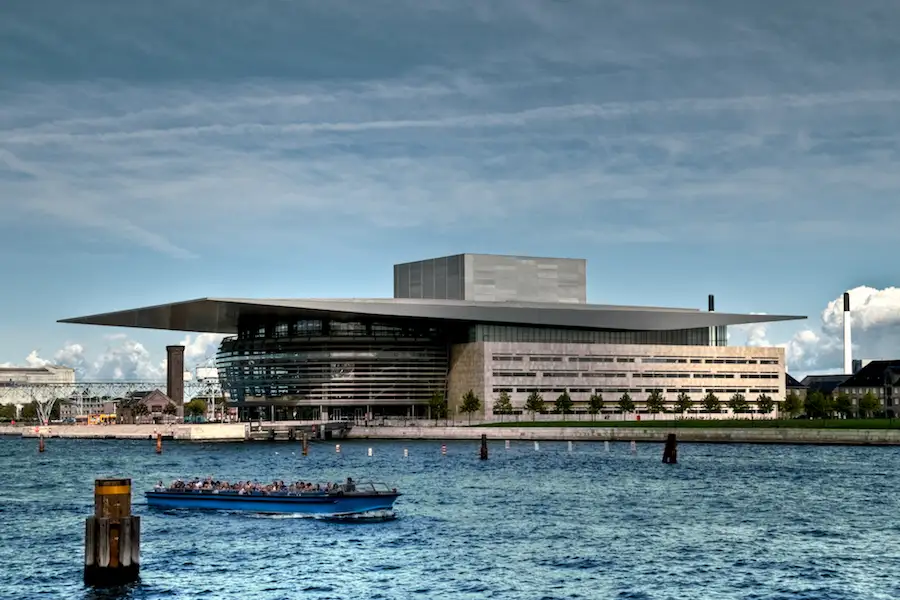
Royal Danish Opera House
 Highlight of Christianshavn
Highlight of ChristianshavnA modern symphony for the ears... and the eyes.
The Copenhagen Opera House, a modern architectural gem designed by Henning Larsen, opened in 2005 on Copenhagen's waterfront. Facing the Amalienborg Palace, it features a main auditorium with outstanding acoustics for 1,400 guests. This venue hosts opera, ballet, and classical concerts, showcasing international and Danish talents. Its striking design, including a vast glass façade, floating roof, and features of fine stone and gold leaf, marks it as a centerpiece of Danish culture and arts.

Freetown Christiania
 Highlight of Christianshavn
Highlight of ChristianshavnAnarchist community as tourist attraction? Read on...
Visiting Freetown Christiania offers a unique glimpse into an alternative way of life in the heart of Copenhagen. This colorful and eclectic community thrives on principles of freedom, creativity, and communal living, making it a fascinating contrast to the city's more traditional European charm. Mural-lined streets, organic cafes and quirky shops, populate this over-50-year-old community. Christiania's open-minded atmosphere and picturesque green spaces provide a peaceful retreat from the hustle and bustle of city life. However, visitors are advised to respect the local guidelines, such as no photography in certain areas, to maintain the community's privacy and unique lifestyle.

Royal Danish Opera House
 Highlight of Christianshavn
Highlight of ChristianshavnA modern symphony for the ears... and the eyes.
The Copenhagen Opera House, a modern architectural gem designed by Henning Larsen, opened in 2005 on Copenhagen's waterfront. Facing the Amalienborg Palace, it features a main auditorium with outstanding acoustics for 1,400 guests. This venue hosts opera, ballet, and classical concerts, showcasing international and Danish talents. Its striking design, including a vast glass façade, floating roof, and features of fine stone and gold leaf, marks it as a centerpiece of Danish culture and arts.

Freetown Christiania
 Highlight of Christianshavn
Highlight of ChristianshavnAnarchist community as tourist attraction? Read on...
Visiting Freetown Christiania offers a unique glimpse into an alternative way of life in the heart of Copenhagen. This colorful and eclectic community thrives on principles of freedom, creativity, and communal living, making it a fascinating contrast to the city's more traditional European charm. Mural-lined streets, organic cafes and quirky shops, populate this over-50-year-old community. Christiania's open-minded atmosphere and picturesque green spaces provide a peaceful retreat from the hustle and bustle of city life. However, visitors are advised to respect the local guidelines, such as no photography in certain areas, to maintain the community's privacy and unique lifestyle.

Royal Danish Opera House
 Highlight of Christianshavn
Highlight of ChristianshavnA modern symphony for the ears... and the eyes.
The Copenhagen Opera House, a modern architectural gem designed by Henning Larsen, opened in 2005 on Copenhagen's waterfront. Facing the Amalienborg Palace, it features a main auditorium with outstanding acoustics for 1,400 guests. This venue hosts opera, ballet, and classical concerts, showcasing international and Danish talents. Its striking design, including a vast glass façade, floating roof, and features of fine stone and gold leaf, marks it as a centerpiece of Danish culture and arts.
prev
next

What's Included In Copenhagen City Break Trip

Pre-Paid Tours and Activities:
- Discover the Hidden Gems of Copenhagen by Boat
- Private Walking Tour of Copenhagen
- City Card for Copenhagen, including discounts to many popular attractions

Go Real Travel Mobile App:
- Itinerary Plan & Reservations Info
- Points of Interest
- Detailed Travel Information
- Maps & Directions
Other Trips You May Like

5 Days
From$1700USD

4 Days
From$949USD

7 Days
From$2299USD

7 Days
From$1995USD

14 Days
From$4550USD
A Taste of Northern Europe: A 14-day trip from Brussels to Copenhagen

Belgium, Netherlands, Germany, Denmark

4 Days
From$897USD

5 Days
From$700USD

4 Days
From$775USD

7 Days
From$1995USD

5 Days
From$1700USD

4 Days
From$949USD

7 Days
From$2299USD

7 Days
From$1995USD

14 Days
From$4550USD
A Taste of Northern Europe: A 14-day trip from Brussels to Copenhagen

Belgium, Netherlands, Germany, Denmark

4 Days
From$897USD

5 Days
From$700USD

4 Days
From$775USD

7 Days
From$1995USD
prev
next
Featured Blogs
prev
next
Our Customers Say It Best
Marianne Strydom, Paarl, South Africa
I just wanted to thank you for organizing an amazing trip for me – I packed in so much in such a short period of time and everything was just perfect. The way you do things makes it possible to really get to know the destination, which for me as a travel agent could not have been better. 

Otto Chuy, Los Angeles, California
I am still surprised how everything worked as planned, without a hitch. All instructions in your itinerary were precise and correct. Your suggestions and comments in each of the locations we went to were very helpful. All your guides, without exception, were wonderful and exactly on time. 

Malini Dutta, Boston, Massachusetts
We can't thank you enough for the detailed plans, maps, and suggestions. It really felt that someone was holding our hands and showing us around. We had all the excitement of discovering foreign lands, with none of the problems that can happen while negotiating unfamiliar places. In fact, all the cities felt like home within a few hours of arriving and exploring. 

Bev and Mark Frankel, Williamsburg, Virginia
We could not be more pleased with Go Real Travel! You took the guess work out of things like public transport but still managed to allow us the freedom to tour as we wanted. Our guides were exceptional and every time I saw a Viking Cruise tour of 25 people, I realized the quality experience we were getting with Go Real. 

Marianne Strydom, Paarl, South Africa
I just wanted to thank you for organizing an amazing trip for me – I packed in so much in such a short period of time and everything was just perfect. The way you do things makes it possible to really get to know the destination, which for me as a travel agent could not have been better. 

Otto Chuy, Los Angeles, California
I am still surprised how everything worked as planned, without a hitch. All instructions in your itinerary were precise and correct. Your suggestions and comments in each of the locations we went to were very helpful. All your guides, without exception, were wonderful and exactly on time. 

Malini Dutta, Boston, Massachusetts
We can't thank you enough for the detailed plans, maps, and suggestions. It really felt that someone was holding our hands and showing us around. We had all the excitement of discovering foreign lands, with none of the problems that can happen while negotiating unfamiliar places. In fact, all the cities felt like home within a few hours of arriving and exploring. 

Bev and Mark Frankel, Williamsburg, Virginia
We could not be more pleased with Go Real Travel! You took the guess work out of things like public transport but still managed to allow us the freedom to tour as we wanted. Our guides were exceptional and every time I saw a Viking Cruise tour of 25 people, I realized the quality experience we were getting with Go Real. 



Explore cities in more detail
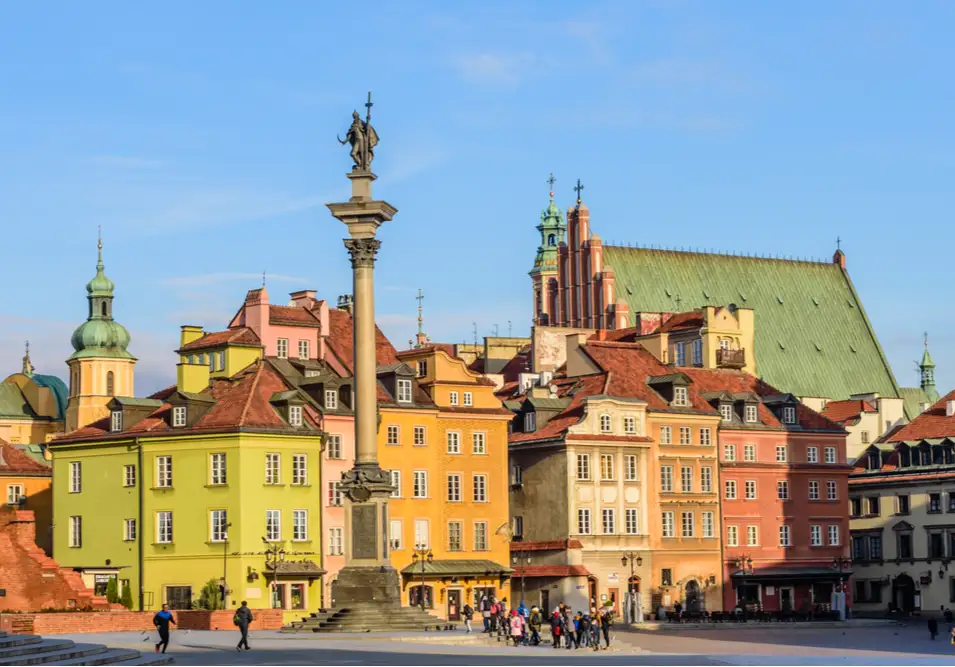
Warsaw
Warsaw is a place that seems almost indestructible. Nearly bombed out of existence in World War II, the city rebuilt itself out of the rubble, and today it’s a shining example of a thriving European capital with a lot to offer. History forms a big part of Warsaw’s allure. Occupied by the Nazis, and losing much of its Jewish population to the Holocaust, Warsaw has several museums dedicated to remembering its dark past. The Warsaw Uprising Museum, POLIN Museum of the History of Polish Jews, and National Museum are among the most prominent. Although its past has been troubled, Warsaw’s present is anything but. The city contains countless opportunities for fun, with a blossoming nightlife scene and a vibrant cafe culture. After a day of wandering through the old streets and charming squares, there are plenty of places to enjoy a meal, from high-end restaurants to affordable milk bars. Warsaw is a place for reflection and remembrance, but also a place that looks firmly towards the future, a future that for this city— appears increasingly bright.

Learn About Warsaw
Build Warsaw Trip

Frankfurt
Dubbed ‘Mainhatten’ for its glass highrises, financial prowess, and proximity to the Main River, Frankfurt offers a fascinating glimpse into the ‘engine room’ of Europe’s economy with an unexpected twist. Among the glass and steel buildings, the old-worldly Römerberg square will give you a double-take. The square’s 15th-century half-timbered houses, old statues, and church spires contrast dramatically against the modern 21st-century skyscrapers beyond. If you visit at Christmas, the Römerberg is truly special, aglow with the light of the tallest Christmas tree in Germany. The square fills with stalls selling handicrafts, and the air is scented with hot apple wine, honey, and cinnamon. Delve deeper into Frankfurt and you’ll find a substantial museum district, the Museumsufer (Museum Embankment). This area features a cluster of twelve museums on either side of Main River. This includes the Städel, home to Tischbein’s famous painting of renowned writer Johann Wolfgang von Goethe, one of Frankfurt’s most prestigious sons. The more time you spend in Frankfurt, the more you’ll discover a highly cultured city lurking beneath its glass facades. If you have the time, Frankfurt is certainly worth a second look.

Learn About Frankfurt
Build Frankfurt Trip
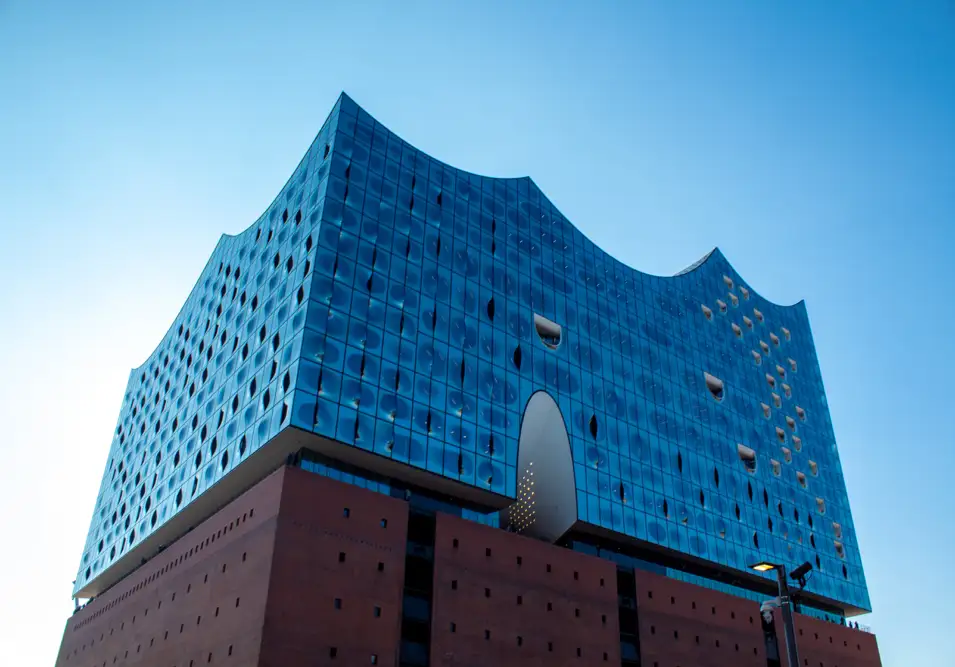
Hamburg
Compared to other German cities, Hamburg has a moody, nautical charisma all of its own. Despite being battered throughout history by floods, fires, and bombs, Hamburg has always held its head up high. Resilience is in the air in Hamburg, along with the briny smell of the North Sea. In recent years Hamburg has garnered a reputation for commerce and nightlife. Frequent travelers whisper that Hamburg is Germany’s ‘undiscovered’ city, the place to go for a little business and a lot of fun. Known as Germany’s ‘gateway to the world’, ships dock in Hamburg as they haul cargo up and down the Elbe River. The city thrives as Germany’s primary seaport and has been a center of trade since the middle ages. Its affluence shows in the 19th-century brick warehouses, flourishing restaurant scene, and recently constructed Elbphilharmonie concert hall, which floats majestically in the harbor, part ship and part island. Hamburg is a city for those who like to live large - in a cultured, German kind of way. Attend a performance at the orchestra, cruise on a boat around the Außenalster Lake, or have a night on the Reeperbahn, the Vegas-like strip where the Beatles once performed. Whatever you do in the city, Hamburg will make you look twice and see Germany from a totally different point of view.

Learn About Hamburg
Build Hamburg Trip

Copenhagen
Copenhagen is a port city in Scandinavia full of artsy museums, windswept castles, and hip restaurants. The city has a relaxed, homey feel. Bicycles zip in and out of leafy boulevards, past bakeries, hotdog stands, and cool cafes. People swim year-round in the pristine waters of the harbor that encircles Copenhagen like a moat around a fortress. Descended from Vikings, Danish people have a familial kinship with the sea. Day trips by train up the spectacular Øresund coast showcase the cobalt blue ocean and sweeping views across to Sweden. A few years ago, Copenhagen was birthplace to a gastronomic revolution known as the New Nordic cuisine. People now come from all over the world to dine in Copenhagen on dishes that speak to the contemporary Danish mentality; clean, simple, and appreciative of all seasons. The quality of food and life in Copenhagen is very high. Maybe it’s the sea air or the Danish eye for design, but people just seem happier in Copenhagen. After spending a day or two here, trying a Smørrebrød sandwich and maybe some aquavit schnapps, you’re bound to take some happiness away with you.

Learn About Copenhagen
Build Copenhagen Trip
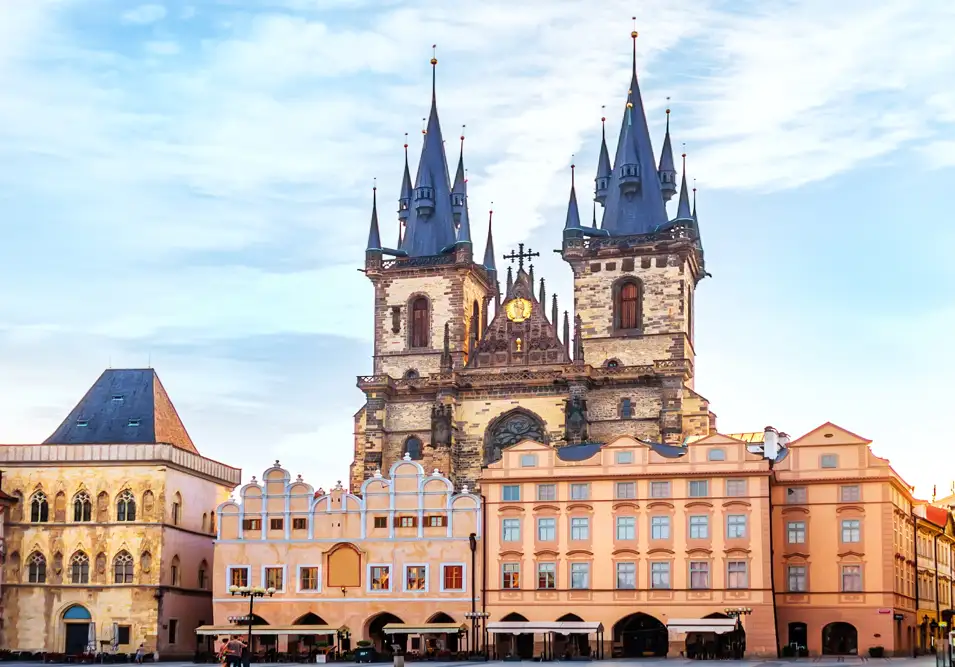
Prague
The city of Prague is indisputably the gem of Central Europe. Full of history, culture, and classic Czech pubs around every corner, Prague is teeming with nooks and crannies just waiting to be discovered. The narrow cobblestone streets and warm red rooftops give the city a homey feel, while the well-preserved medieval architecture transports you back in time. Walking across the Charles Bridge with the view of the Prague Castle will make you feel like you’re living in a fairytale, and you might as well be. As an up-and-coming destination, Prague is a perfect mix of classic and modern. New trendy cafes and bistros are always popping up, and you can always find a group of lively locals chowing down on goulash and quaffing pivo (the best beer in Europe!) at traditional Czech restaurants across the city. The clash of modernity and tradition, preservation and innovation, gives this city a mysterious air that you won’t soon forget.

Learn About Prague
Build Prague Trip
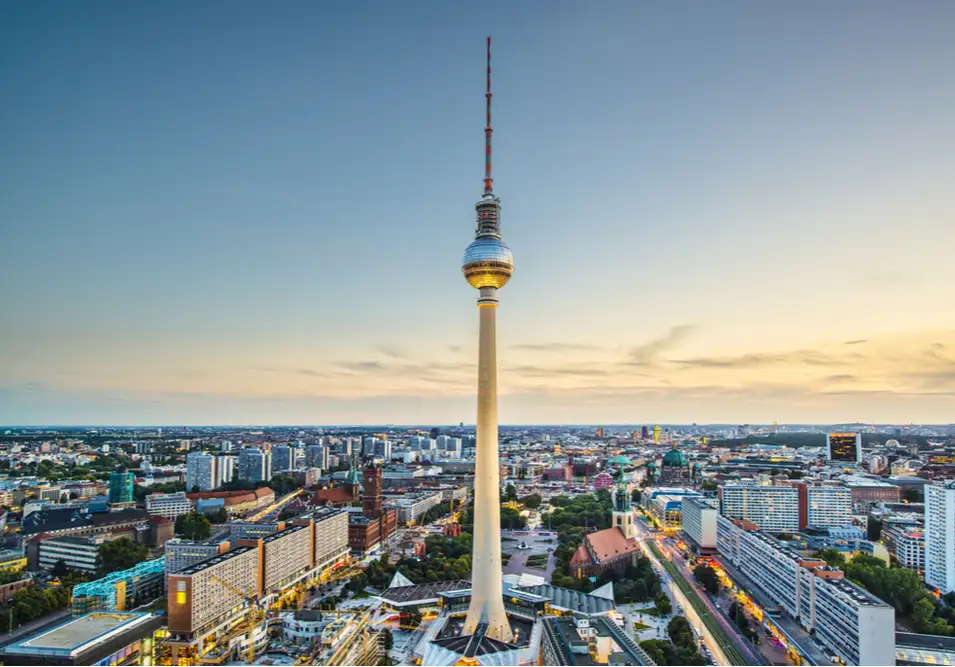
Berlin
Since the fall of its notorious wall, Berlin’s unification has seen it go from strength to strength. No wonder the city feels like it hasn’t stopped partying since the 1990s. There is so much to celebrate here. Fueled by the robust economy, a thriving tech scene, and straight-up German bonhomie, when you step into Berlin you’ll soon be caught up in its spirit. For all this gusto, Berlin hasn’t forgotten its troubled past. A visit to Berlin is to bear witness to history. Portions of the wall remain intact, and the city’s Jewish Museum offers a detailed, emotional examination of the Holocaust. Inside the reconstructed Reichstag, every attempt has been made to preserve the parliament’s beleaguered history. The buildings' glass dome addition feels less like a triumphal crown and more like a freshly healed battle scar. Days in Berlin are easily spent wandering from a cafe to the cultural institutions on Museum Island, or over to the Charlottenburg Palace. By night, crowds wander through the booming bars and nightclubs or gaze upon the floodlit Brandenburg Gate and Victory Column monuments. An international city that can offer something to everyone, Berlin is an unmissable stop on your German journey.

Learn About Berlin
Build Berlin Trip

Warsaw
Warsaw is a place that seems almost indestructible. Nearly bombed out of existence in World War II, the city rebuilt itself out of the rubble, and today it’s a shining example of a thriving European capital with a lot to offer. History forms a big part of Warsaw’s allure. Occupied by the Nazis, and losing much of its Jewish population to the Holocaust, Warsaw has several museums dedicated to remembering its dark past. The Warsaw Uprising Museum, POLIN Museum of the History of Polish Jews, and National Museum are among the most prominent. Although its past has been troubled, Warsaw’s present is anything but. The city contains countless opportunities for fun, with a blossoming nightlife scene and a vibrant cafe culture. After a day of wandering through the old streets and charming squares, there are plenty of places to enjoy a meal, from high-end restaurants to affordable milk bars. Warsaw is a place for reflection and remembrance, but also a place that looks firmly towards the future, a future that for this city— appears increasingly bright.

Learn About Warsaw
Build Warsaw Trip

Frankfurt
Dubbed ‘Mainhatten’ for its glass highrises, financial prowess, and proximity to the Main River, Frankfurt offers a fascinating glimpse into the ‘engine room’ of Europe’s economy with an unexpected twist. Among the glass and steel buildings, the old-worldly Römerberg square will give you a double-take. The square’s 15th-century half-timbered houses, old statues, and church spires contrast dramatically against the modern 21st-century skyscrapers beyond. If you visit at Christmas, the Römerberg is truly special, aglow with the light of the tallest Christmas tree in Germany. The square fills with stalls selling handicrafts, and the air is scented with hot apple wine, honey, and cinnamon. Delve deeper into Frankfurt and you’ll find a substantial museum district, the Museumsufer (Museum Embankment). This area features a cluster of twelve museums on either side of Main River. This includes the Städel, home to Tischbein’s famous painting of renowned writer Johann Wolfgang von Goethe, one of Frankfurt’s most prestigious sons. The more time you spend in Frankfurt, the more you’ll discover a highly cultured city lurking beneath its glass facades. If you have the time, Frankfurt is certainly worth a second look.

Learn About Frankfurt
Build Frankfurt Trip

Hamburg
Compared to other German cities, Hamburg has a moody, nautical charisma all of its own. Despite being battered throughout history by floods, fires, and bombs, Hamburg has always held its head up high. Resilience is in the air in Hamburg, along with the briny smell of the North Sea. In recent years Hamburg has garnered a reputation for commerce and nightlife. Frequent travelers whisper that Hamburg is Germany’s ‘undiscovered’ city, the place to go for a little business and a lot of fun. Known as Germany’s ‘gateway to the world’, ships dock in Hamburg as they haul cargo up and down the Elbe River. The city thrives as Germany’s primary seaport and has been a center of trade since the middle ages. Its affluence shows in the 19th-century brick warehouses, flourishing restaurant scene, and recently constructed Elbphilharmonie concert hall, which floats majestically in the harbor, part ship and part island. Hamburg is a city for those who like to live large - in a cultured, German kind of way. Attend a performance at the orchestra, cruise on a boat around the Außenalster Lake, or have a night on the Reeperbahn, the Vegas-like strip where the Beatles once performed. Whatever you do in the city, Hamburg will make you look twice and see Germany from a totally different point of view.

Learn About Hamburg
Build Hamburg Trip

Copenhagen
Copenhagen is a port city in Scandinavia full of artsy museums, windswept castles, and hip restaurants. The city has a relaxed, homey feel. Bicycles zip in and out of leafy boulevards, past bakeries, hotdog stands, and cool cafes. People swim year-round in the pristine waters of the harbor that encircles Copenhagen like a moat around a fortress. Descended from Vikings, Danish people have a familial kinship with the sea. Day trips by train up the spectacular Øresund coast showcase the cobalt blue ocean and sweeping views across to Sweden. A few years ago, Copenhagen was birthplace to a gastronomic revolution known as the New Nordic cuisine. People now come from all over the world to dine in Copenhagen on dishes that speak to the contemporary Danish mentality; clean, simple, and appreciative of all seasons. The quality of food and life in Copenhagen is very high. Maybe it’s the sea air or the Danish eye for design, but people just seem happier in Copenhagen. After spending a day or two here, trying a Smørrebrød sandwich and maybe some aquavit schnapps, you’re bound to take some happiness away with you.

Learn About Copenhagen
Build Copenhagen Trip

Prague
The city of Prague is indisputably the gem of Central Europe. Full of history, culture, and classic Czech pubs around every corner, Prague is teeming with nooks and crannies just waiting to be discovered. The narrow cobblestone streets and warm red rooftops give the city a homey feel, while the well-preserved medieval architecture transports you back in time. Walking across the Charles Bridge with the view of the Prague Castle will make you feel like you’re living in a fairytale, and you might as well be. As an up-and-coming destination, Prague is a perfect mix of classic and modern. New trendy cafes and bistros are always popping up, and you can always find a group of lively locals chowing down on goulash and quaffing pivo (the best beer in Europe!) at traditional Czech restaurants across the city. The clash of modernity and tradition, preservation and innovation, gives this city a mysterious air that you won’t soon forget.

Learn About Prague
Build Prague Trip

Berlin
Since the fall of its notorious wall, Berlin’s unification has seen it go from strength to strength. No wonder the city feels like it hasn’t stopped partying since the 1990s. There is so much to celebrate here. Fueled by the robust economy, a thriving tech scene, and straight-up German bonhomie, when you step into Berlin you’ll soon be caught up in its spirit. For all this gusto, Berlin hasn’t forgotten its troubled past. A visit to Berlin is to bear witness to history. Portions of the wall remain intact, and the city’s Jewish Museum offers a detailed, emotional examination of the Holocaust. Inside the reconstructed Reichstag, every attempt has been made to preserve the parliament’s beleaguered history. The buildings' glass dome addition feels less like a triumphal crown and more like a freshly healed battle scar. Days in Berlin are easily spent wandering from a cafe to the cultural institutions on Museum Island, or over to the Charlottenburg Palace. By night, crowds wander through the booming bars and nightclubs or gaze upon the floodlit Brandenburg Gate and Victory Column monuments. An international city that can offer something to everyone, Berlin is an unmissable stop on your German journey.

Learn About Berlin
Build Berlin Trip
prev
next


 Map of Your Itinerary Route
Map of Your Itinerary Route
Zoom In to the cities to see your itinerary in more detail


 4.8
4.8 








